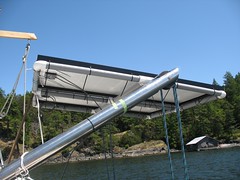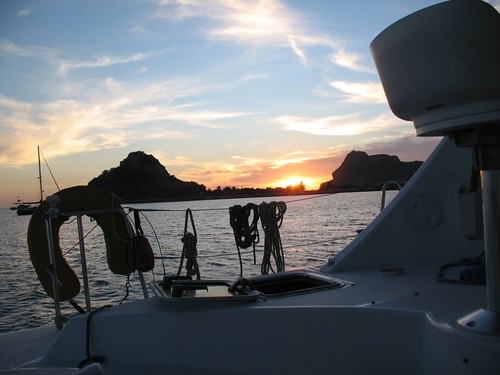We have to make every erg of electrical energy we use. Not surprisingly, this makes us very stingy consumers of electricity. On a boat, there are five ways to produce electricity:
Hook to shore power - You can buy electrical at a marina. Sometimes it comes with the dock fee, sometimes there is an extra charge. In either case, it costs a lot of money to tie up. We anchor out as much as possible so it does not behoove us to rely too heavily on topping off the batteries on a dock.
Generators and engines - You can use alternators to charge your batteries by burning fossil fuels either in your engines or a generator. In both cases, however, you are engaged in that environmentally icky and incredibly expensive process -- converting dinosaurs to lumens. We prefer to charge our batteries this way only as a by-product of moving the boat. It is depressing how often weather and timing force our sail boat to be a very slow motor boat. When this happens, we call the energy that flows into our batteries “bonus points.”
Solar panels - We have two panels and a solar charge controller. The entire setup, including DrC’s nifty kludge of a mounting panel, cost us roughly two boat bucks. We consistently get about 15 amps an hour during the day. Let’s call it about 100 per day. More panels gets you more power. On a boat, it’s rather challenging figuring out where to put them. The great thing about solar panels is that if you set them up correctly, you can then forget their very existence. They just keep pumping out power.
Wind generator - Many cruising boats travel with a wind generator. We do not, but maybe someday we’ll add it to the boat. The principle advantage of a wind generator is that it can produce energy 24 hours per day. The disadvantages are the noise and that they require a lot of baby sitting. It is a very bad idea to forget you have a wind generator when you are in high winds. Even so, it’s very tempting to add one to the boat.
The final way to generate power is the most important -- don’t use it. Just as on land, the amp you don’t use is the cheapest one to generate. Boaters in general are pretty clever about reducing consumption. I’d like to think on Don Quixote we’re doing a reasonably good job. I’ll start with a list of ways we conserve, but this is one of those times where I would really like people to actively contribute additional suggestions. Other boaters have no doubt developed very creative ways to reduce their use of electricity.
LEDs - An expensive but very efficient way to reduce consumption is to switch all the lights on the boat from incandescent to LED. The masthead light, for example, burns all night to alert boats moving through the anchorage of our location. At 2 amps per hour, that’s roughly 24 amps a day. The LED version consumes roughly 2 amps for the entire night.
Ditch the Power Toys - Some power tools make for a much safer cruise as you can fix your own equipment, sew your own covers, or build your own furniture. Others just take up space and weight and consume a lot of power. Ditch the microwave, bread maker, hair dryer, coffee maker, and blender. Dispense with every power sucker and change your lifestyle. As an example, we use a manual coffee grinder from the Lehman’s catalog. It’s beautiful and slows our consumption considerably.
Guard Against Vampires - Chargers for phones, iPods, laptops, GPS and VHF handhelds, and other such little toys consume energy, even after your device is fully charged. Surprisingly, the amount of energy they draw even fully charged is actually quite substantial. We put all these devices on a single power strip. We control the entire strip with a single button. This enables us to charge everything for a few hours, then cut off the charger vampires in one swift stroke. A side benefit is safety since batteries, battery chargers, and transformers have a well-deserved reputation for periodically setting themselves ablaze.
Change Your Sleeping Habits - Wake with the dawn, go to bed at sunset. There is something satisfying about this from a biorythmical standpoint, and it saves a great deal of juice. Another benefit of going to bed early is you watch a lot less television. We thought we’d watch movies regularly. Instead, we’ve been traveling for seven months and have watched a mere handful.
Plan the Refrigerator - We still haven’t mastered Ninja Refrigerator Stowage, but done correctly you can substantially reduce consumption. Organize the fridge so that the things you need are in the front, easy to get to. Meals are grouped on back shelves. True ninjas can actually restrict opening the fridge to a three times a day activity, once for each meal. We know of one family that has it down to once a day. I dream of this capacity for advanced thinking.
So, now you. Boaters, tell me how to save more power. We had reached that enviable state where we could live on the hook for nearly a week, but as we dropped to warmer latitudes, the increased power to fridge and freeze tipped us over into running the engine every third day. Help me out!



4 comments:
Well, turning off the fridge is one way. I just read a fantastic article in Cruising World: "Cruising without the fridge" and it was by and far the most helpful article on food storage that I have read. The author has cruised for more than 12 years sans fridge, and shared ways to go without one and have yummy fresh food.
It is the route we will go this summer while cruising around. As much as I loath a warm beer, we are fridge impaired on our boat, so the article was very helpful for me in planning how to keep the food fresh without one.
Here is something to consider:
The Sterling cycle fridge. Extremely energy efficient. There has been in depth discussion on this in Cruisers Forums - look for "Coleman Stirling" ( http://www.cruisersforum.com/forums/f115/coleman-stirling-power-coolers-12685.html )
Twinbird has some add-in units that are supposed to work very well to retro fit.
This is what we will be using when we build our fridge in our boat.
We "RV" but hey, a rose is a rose. As with boat and rv refrigerators, they are very small. We place bottles/jugs of drinking water into our frig as space opens but only when we are plugged in or gen'ing power. To put it simply, this converts power to cold that is stored in the water and this will maintain a marked lower temp. when the door is opened and take less running time to reach the set mean temp., and you can swap out the "cold ones" and enjoy the fruits when the juice is flowing. AAAhhh, Life is goooood! Empty space in your frig. or freezer has to be re-chilled everytime you open the door and that takes power, so fill it up.
As you know, the little things mean alot and if you time it right this tip can save alot.
On another note, hey Toast, while you're out battling windmills and you conquer 1 or 2, we would love to see you celebrate with a smile.
All the Best, M & little c
oy, no silver bullets here. If you want to use less, instead of bringing in more... I guess I'd do an amp inventory (resting and charging rates), then use the info to find anything you can live without - or prefer to suck up the cost of replacing. My gut says your refrigeration is a major culprit (can only speculate on your freezer unit)- the front-door style just dumps all that cold air when it's opened(and seriously, with the girls- do you really keep it to 3x/day overall?). Then look at what you're taking out for the various and sundry electronics, although my guess is these are a distanct 2nd.
we're already thinking about June-Sept, man oh man, it's going to be a hot summer!!
Post a Comment